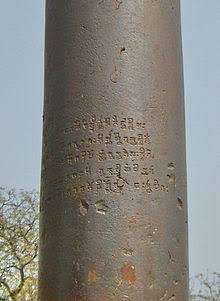Delhi's Iron Pillar.
The Iron Pillar is situated in the courtyard of the Quwwat-ul-Islam mosque at the Qutub Complex at Mehralui in Delhi,India. The height of the pillar, from the top to the bottom is 7.21 m (23 ft. 8 inch), 1.12 m (3 ft. 8 inch) of which is below ground. Its bell pattern capital is 306 mm (12 inch). It is estimated that the weight of Iron Pillar is more than six tonnes. It was constructed by King Chandra probably Chandragupta 2 in 5th Century CE. This Pillar eminent for non-rusted state in spite of being made of 98% Iron. This pillar is unique in the annals of metallurgy and a wonderful example of the metallurgical skill of ancient Indians. It is very fascinating place for tourists . Till Now, Many archaeologists, metallurgists , technologists , scientists, electrochemists and engineers had studied about this metallurgical marvel of ancient India. It has won the unstinted admiration all who have seen it.
Iron Pillar at DelhiThe story of Iron Pillar of Delhi marks the history of this metallurgical wonder and recounts that it was constructed in Udayagiri. Originally , This pillar was installed on a top of the hill near Udayagiri in the Hinterland of Madhya Pradesh during the reign of Chandragupta II Vikramaditya (374-413 A.D.) of Gupta Dynasty. The original site of the pillar was where the imaginary line that is the tropic of cancer crosses India from where one can spot the sun rising in the east and setting in the west on spring and autumn equinox days. Though In 1234 , King Iltutmish (1210-36 AD) the third sultan of Delhi’s slave dynasty captured Udayagiri and transferred the pillar to Delhi as part of his victory booty.
InscriptionsThis pillar have number of epigraphs and graffiti of different dates which have not studied yet. Inscribed on its shaft, on the side facing the mihrab arches of the ancient mosque, is a deeply incised inscription. This ancient inscription, in the Sanskrit language and Brahmi script, belongs palaeographically to the 4th century CE and is called ‘Gupta Brahmi’ after the Gupta Empire that ruled Northern and Central India from the 4th to the 7th century CE. This Gupta period Brahmi script states that the pillar was erected in the honour of Lord Vishnu. It also praises the valor and qualities of the king referred to Chandra. Now generally identified with the name of Gupta king Chandragupta II. Some authors tried to identify ‘Chandra' as Chandragupta Maurya but other have claimed the date of pillar as early as 912 BCE. The dating of inscription is supported by the nature of script and the Sanskrit poetics , Both of which reflects the convention of Gupta times. That Iron Pillar is indeed an engineering marvel was conceded by the President of the Institute of Mechanical Engineering ,London.
In 2002 , Scientists studied Iron Pillar and realised that It has a strange way of reacting with atmosphere. In chemistry , we see that when Iron react with moisture in the atmosphere and produce Iron Oxide which is called Rust (Fe2O3).This is very powerful , It will decay the iron and eventually destroy the entire structure. However , When Iron Pillar come in contact with moisture, it form strange material called Misawite (y-FeOOH),which has not been seen anywhere before. This strange material forms a protective coating over Iron Pillar and shields it from rusting and also increase its magnetic property. Now , we see how does Iron pillar create Misawite instead of making Iron Oxide? What make this iron pillar to form such strange compound that is not seen anywhere else?
Delhi Iron Pillar is a symbol of India’s metallurgical pride and heritage. It is excellent example that shows how innovative the ancient Indians Blacksmiths are!



Nice veerji ..keep it up jio..👍🏻🌟
ReplyDelete